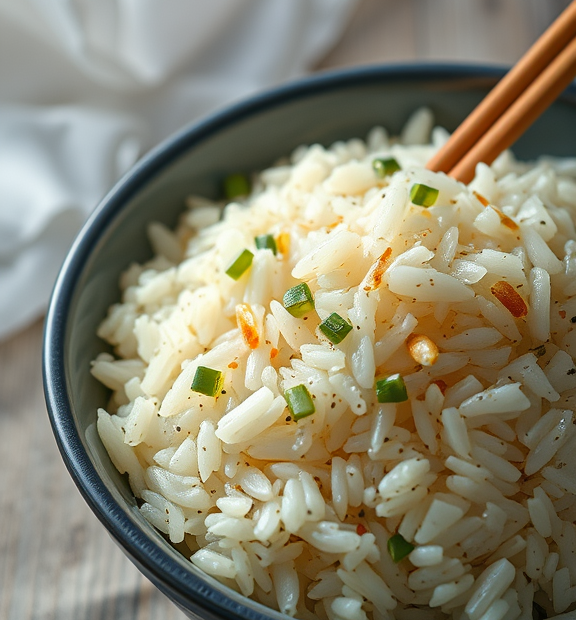The Science Behind Cold Rice: Why Does It Have Fewer Carbs?
Have you ever wondered why cold rice seems to have fewer carbs than freshly cooked warm rice? You’re not the only one! Many people have turned to sites like Reddit to explore the science behind this phenomenon. Let’s dive into the exciting world of starch and how temperature impacts carbohydrate content. Understanding this concept can help you make better choices for your meals.
Rice is primarily made up of carbohydrates, and these carbs come in different forms. The main type of carbohydrate in rice is starch. Starch is made up of long chains of glucose molecules, and how this starch is structured can influence how your body digests it. When rice is cooked, the heat breaks down the starch granules, making them more accessible for digestion.
However, when rice cools down, something interesting happens: a process called retrogradation occurs. During retrogradation, some of the starch molecules realign themselves into a tighter, more crystalline structure. This makes the starch harder to digest. Consequently, your body absorbs fewer calories and carbs from cold rice compared to its warm counterpart.
Here are some key points that explain this phenomenon:
- Starch Gelatinization: When rice cooks, starch granules swell and absorb water, becoming soft and sticky. This gelatinization phase makes the carbs readily digestible.
- Retrogradation: Cooling rice allows some of the gelatinized starch to realign into a more resistant form. This resistant starch is not easily broken down in the digestive system.
- Digestive Impact: Since resistant starch is less digestible, it functions more like fiber. Eating cold rice means fewer calories and carbs get absorbed into your body.
Studies show that the temperature of cooked rice can affect how many carbs you consume. In one study, researchers found that cooling cooked rice overnight could increase the amount of resistant starch by up to 60%. This means that by simply chilling your rice before eating, you are changing its nutritional profile significantly.
This is particularly beneficial for those looking to manage their carbohydrate intake, such as individuals with diabetes or those following a low-carb diet. Consuming cold rice can help regulate blood sugar levels and keep you feeling fuller for longer due to its higher fiber content.
If you’re thinking about incorporating cold rice into your meals, you might try making a delicious rice salad or a sushi bowl. These dishes not only taste great but also provide a healthy alternative that helps control your carb intake. Cold rice can be enjoyed in various recipes, making it a versatile ingredient in healthy cooking.
Love what I do? Be a hero and help me keep creating awesome content!
Support My Mission Now!Every donation fuels more great stuff – thank you, legend!
While cold rice does have fewer digestible carbs, moderation is key. It’s still important to pay attention to portion sizes, especially if you’re tracking your carbohydrate intake. Additionally, adding nutritious elements like vegetables, lean proteins, or healthy fats can enhance your meal without significantly increasing your carb count.
Next time you prepare rice, try letting it cool before serving. You can store leftover rice in the refrigerator for several days and utilize it in various dishes throughout the week. This easy strategy not only lowers the carb content but also adds a simple twist to your meals.
Love what I do? Be a hero and help me keep creating awesome content!
Support My Mission Now!Every donation fuels more great stuff – thank you, legend!
The intrigue of cold rice reveals much about how our food interacts with our bodies. By understanding the science behind it, you can make informed choices that benefit your health and help you maintain a balanced diet. Experiment with cold rice and reap the benefits while enjoying delicious meals! Remember, it’s not just about the number of carbs but also about how they impact your body.
Health Benefits of Eating Cold Rice Compared to Hot Rice
Cold rice has been gaining popularity as a meal choice over hot rice, and many are curious about the health benefits that come with it. If you’ve stumbled upon discussions on platforms like Reddit, you might be intrigued by why cold rice is considered more beneficial compared to its hot counterpart. Let’s explore the key advantages of making cold rice a part of your diet.
Understanding the Science Behind Cold Rice
When rice is cooked and then cooled, a process called retrogradation occurs. During this process, some of the starches in the rice transform into a form known as resistant starch. Unlike regular starch, resistant starch isn’t fully broken down in your digestive system. This not only lowers the calorie count but also brings several health perks with it.
Health Benefits of Cold Rice
Love what I do? Be a hero and help me keep creating awesome content!
Support My Mission Now!Every donation fuels more great stuff – thank you, legend!
There are numerous health benefits tied to consuming cold rice that make it worth considering:
- Lower Carb Content: Cold rice has reduced digestible carbs compared to hot rice because of the presence of resistant starch. This means fewer calories can lead to better weight management.
- Better Blood Sugar Control: Eating cold rice can aid in stabilizing blood sugar levels. The slow digestion of resistant starch can prevent rapid spikes in blood sugar, making it a better option for those managing diabetes.
- Improved Gut Health: Resistant starch acts as a prebiotic, promoting the growth of healthy gut bacteria. This can enhance digestion and may reduce the risk of gastrointestinal issues.
- Feeling Full Longer: Cold rice may help you feel fuller for a longer time. The slower digestion process means you’ll likely experience a more sustained feeling of satiety.
- Weight Loss Friendly: Reduced calorie intake and improved satiety can aid in weight loss efforts. Consuming cold rice as part of a balanced meal helps in maintaining a healthy weight while keeping cravings at bay.
How to Incorporate Cold Rice in Your Diet
Now that you understand the benefits, you might wonder how to add cold rice into your meals. Here are some simple meal ideas:
- Cold Rice Salads: Combine cooked and cooled rice with fresh vegetables, herbs, and a dressing for a nutritious salad.
- Rice Bowls: Layer cold rice with different proteins like grilled chicken, beans, or tofu, and top with your favorite sauce.
- Sushi Rolls: Use cold rice as a base for making sushi or rice paper rolls with vegetables and proteins.
- Breakfast Bowls: Add cold rice to yogurt bowls topped with fruits and nuts for a unique breakfast option.
Storage Tips for Cold Rice
Love what I do? Be a hero and help me keep creating awesome content!
Support My Mission Now!Every donation fuels more great stuff – thank you, legend!
To reap the health benefits of cold rice, proper storage is essential. Here’s how to ensure your rice stays safe and delicious:
- Cool Quickly: After cooking, cool the rice quickly to room temperature. This helps prevent the growth of harmful bacteria.
- Store in the Fridge: Keep the cooled rice in an airtight container in the refrigerator. It’s best used within 3-5 days.
- Reheat Safely: If you choose to reheat cold rice, make sure it’s heated thoroughly before consuming to eliminate any potential foodborne illnesses.
In the realm of healthy eating, cold rice offers unique benefits that appeal to many. It provides lower calories, supports gut health, and helps maintain stable blood sugar levels, making it a smart choice for those seeking a healthier lifestyle. With easy and delicious ways to incorporate it into your meals, you may find cold rice a refreshing addition to your kitchen pantry. Whether you choose to enjoy it in a salad or as part of a rice bowl, you can savor the health advantages that accompany this chilled delight.
Conclusion
Understanding why cold rice has fewer carbohydrates than hot rice can be both fascinating and beneficial for your dietary choices. When rice is cooked, its starches gelatinize, making it easy for your body to digest and absorb the carbs. However, when rice is cooled, a process known as retrogradation occurs. This process transforms some digestible starches into resistant starch. Resistant starches are not absorbed in the same way as regular carbohydrates, meaning that by enjoying rice cold, you can effectively lower your overall carb intake.
Cold rice into your meals offers a variety of health benefits. First, it’s a great addition to salads and cold dishes, providing texture and flavor without the high carbohydrate load. Plus, resistant starch is known to improve gut health by feeding the beneficial bacteria in your intestines. This can lead to better digestion and even aid in weight management.
You might also find that cold rice has a lower glycemic index, helping to maintain stable blood sugar levels. This is especially important if you’re watching your carbohydrate intake or managing conditions like diabetes. Ultimately, opting for cold rice might not only satisfy your hunger but also support a healthier lifestyle.
Experiment with different recipes, like cold rice salads or sushi, and reap the nutritional benefits that this versatile grain can provide. By choosing cold rice, you can enjoy a delicious, filling meal while keeping your carbohydrates in check. So next time you make rice, consider letting it cool before you dig in!

